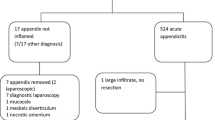Abstract
The diagnosis of uncomplicated acute appendicitis is often straightforward, allowing timely appendicectomy without the need for expensive tests or imaging. Repeated clinical examination by an experienced surgeon has traditionally been the key to making the diagnosis in both straightforward and difficult cases. Nonetheless, all surgeons will remove some normal appendices. Sometimes it can be particularly difficult to make the diagnosis, especially in the child under 5 years of age, in teenage girls, in young women and in the elderly. When difficult to make, the diagnosis may be significantly delayed and since the pathology is progressive, the patient may suffer potentially avoidable complications. This paper looks at two potential roles for imaging. Firstly, can imaging, applied selectively, help make the difficult diagnosis less difficult and so reduce delays and morbidity? Secondly, could imaging all patients with suspected appendicitis reduce the number of normal appendices removed from children who seem to have all the signs and symptoms of straightforward uncomplicated acute appendicitis but who actually have presumed self-resolving non-appendiceal pathology? The answer to these questions may depend on three factors that are not entirely independent: a surgical unit’s current audited negative appendicectomy rate, population base/case mix and the expertise of the examining surgeon. Individual surgeons and some surgical units, by policy, use modern imaging techniques with quite different frequencies that may be appropriate depending on these three factors. This article argues that a careful history and repeated clinical examination is the key to making the diagnosis, with imaging, primarily ultrasonography, being used in patients with a palpable mass or in those having had 48 h of hospital observation without progress. In Europe, imaging has played a limited role in the investigation of the child with suspected appendicitis with the diagnosis relying on repeated examination by an experienced clinician. Ongoing changes in surgical training in the UK may affect the acquisition of clinical expertise that is crucial to this clinical management. High-quality surgical training and surgical audit are needed to monitor the delivery of care and to ensure that the care pathway being used is appropriate for the local resources and population.
Similar content being viewed by others
References
Simpson J, Scholefield JH (2006) Acute appendicitis. The foundation years, vol 2. Elsevier, pp 72–75
Lee SL, Ho HS (2006) Acute appendicitis: is there a difference between children and adults? Am Surg 72:409–413
Calder JD, Gajraj H (1995) Recent advances in the diagnosis and treatment of acute appendicitis. Br J Hosp Med 54:129–133
van den Broek WT, van der Ende ED, Bijnen AB, et al (2004) Which children could benefit from additional diagnostic tools in case of suspected appendicitis? J Pediatr Surg 39:570–574
Sitter H, Hoffmann S, Hassan I, et al (2004) Diagnostic score in appendicitis. Validation of a diagnostic score (Eskelinen score) in patients in whom acute appendicitis is suspected. Langenbecks Arch Surg 389:213–218
Pruekprasert P, Maipang T, Geater A, et al (2004) Accuracy in diagnosis of acute appendicitis by comparing serum C-reactive protein measurements, Alvarado score and clinical impression of surgeons. J Med Assoc Thai 87:296–303
Karakas SP, Guelfguat M, Leonidas JC, et al (2000) Acute appendicitis in children: comparison of clinical diagnosis with ultrasound and CT imaging. Pediatr Radiol 30:94–98
Rettenbacher T, Hollerweger A, Gritzmann N, et al (2002) Appendicitis: should diagnostic imaging be performed if the clinical presentation is highly suggestive of the disease? Gastroenterology 123:992–998
Flum DR, Koepsell T (2002) The clinical and economic correlates of misdiagnosed appendicitis: nationwide analysis. Arch Surg 137:799–804
Rosendahl K, Aukland SM, Fosse K (2004) Imaging strategies in children with suspected appendicitis. Eur Radiol 14 [Suppl 4]:L138–L145
Kaiser S, Frenckner B, Jorulf HK (2002) Suspected appendicitis in children: US and CT. A prospective randomised study. Radiology 223:633–638
Addiss DG, Shaffer N, Fowler BS, et al (1990) The epidemiology of appendicitis and appendectomy in the United States. Am J Epidemiol 132:910–925
Korner H, Sondenaa K, Soreide JA, et al (1997) Incidence of acute nonperforated and perforated appendicitis: age-specific and sex-specific analysis. World J Surg 21:313–317
Acknowledgement
I would like to thank Mr. Bruce Okoye for help with collecting the data on our department’s cases of right iliac fossa pain.
Author information
Authors and Affiliations
Corresponding author
Rights and permissions
About this article
Cite this article
Lander, A. The role of imaging in children with suspected appendicitis: the UK perspective. Pediatr Radiol 37, 5–9 (2007). https://doi.org/10.1007/s00247-006-0304-1
Received:
Revised:
Accepted:
Published:
Issue Date:
DOI: https://doi.org/10.1007/s00247-006-0304-1




